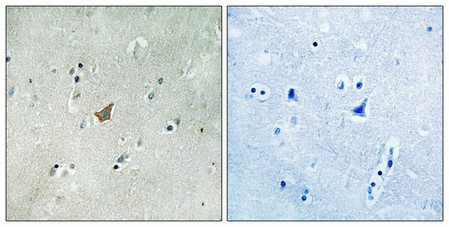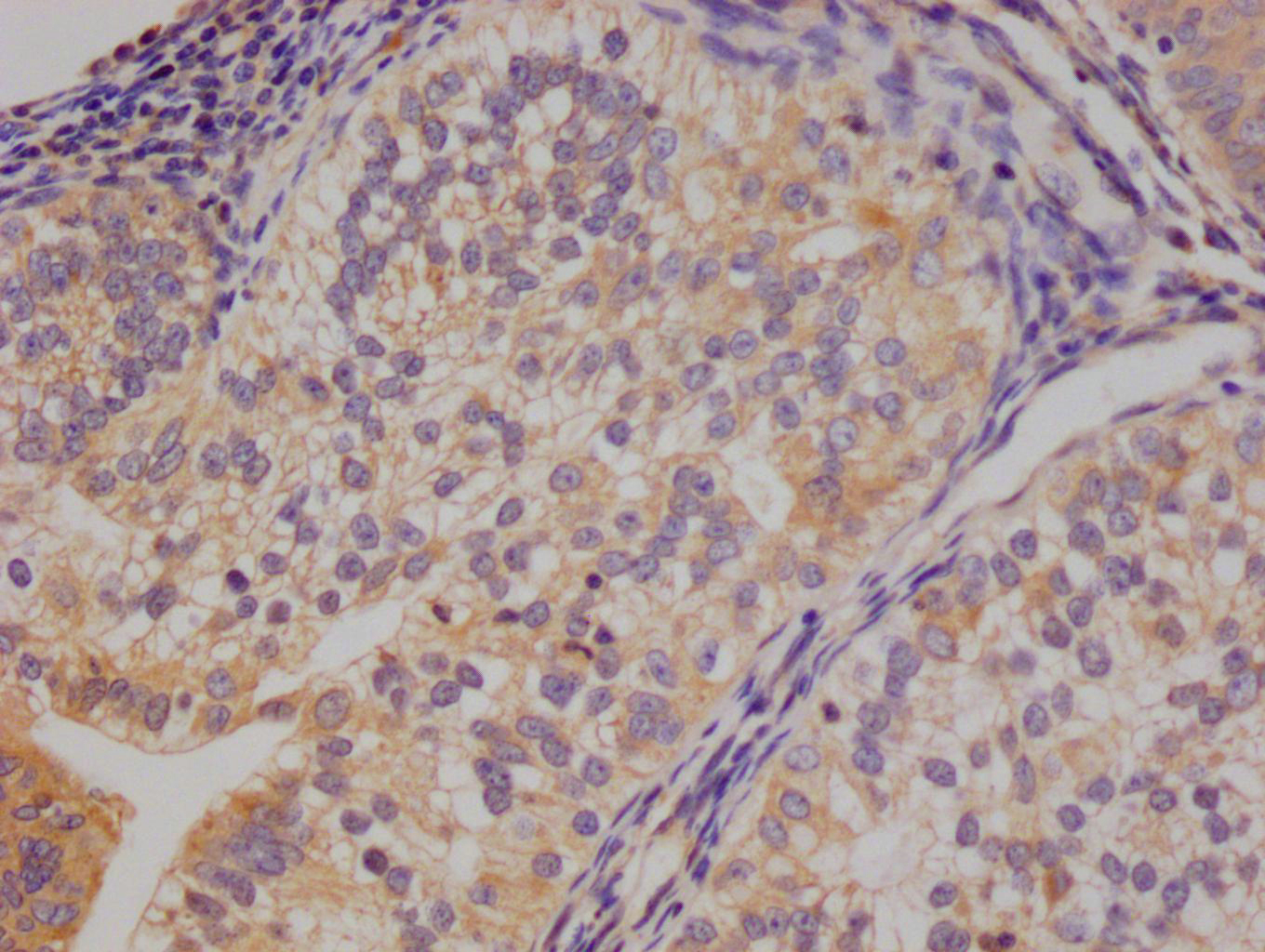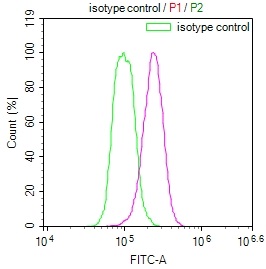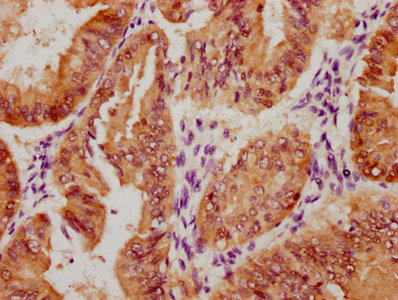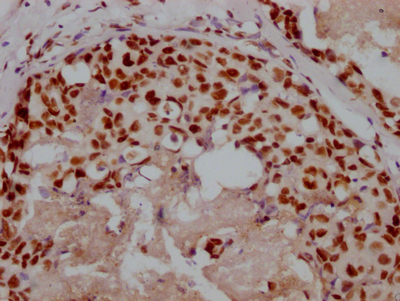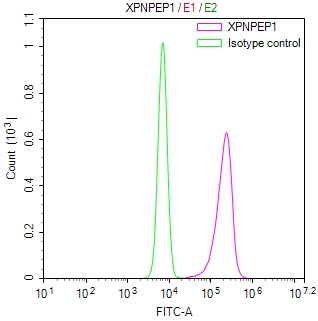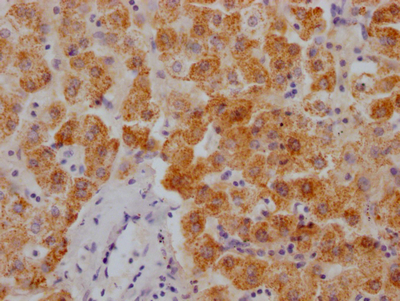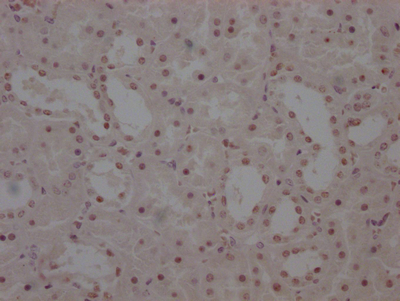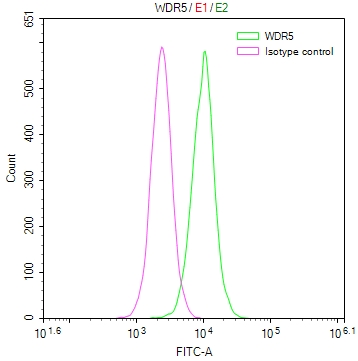Phospho-EPHA3 (Tyr779/833) Antibody
-
中文名稱:磷酸化-EPHA3 (Tyr779/833)兔多克隆抗體
-
貨號(hào):CSB-PA159480
-
規(guī)格:¥2454
-
圖片:
-
其他:
產(chǎn)品詳情
-
產(chǎn)品名稱:Rabbit anti-Homo sapiens (Human) EPHA3 Polyclonal antibody
-
Uniprot No.:
-
基因名:
-
宿主:Rabbit
-
反應(yīng)種屬:Human,Mouse,Rat
-
免疫原:Peptide sequence around phosphorylation site of tyrosine 779/833 (E-A-Y(p)-T-T)/(Q-D-V(p)-I-K) derived from Human EPHA3/4/5.
-
免疫原種屬:Homo sapiens (Human)
-
克隆類型:Polyclonal
-
純化方式:Antibodies were produced by immunizing rabbits with synthetic phosphopeptide and KLH conjugates. Antibodies were purified by affinity-chromatography using epitope-specific phosphopeptide. Non-phospho specific antibodies were removed by chromatogramphy usi
-
濃度:It differs from different batches. Please contact us to confirm it.
-
產(chǎn)品提供形式:Liquid
-
應(yīng)用范圍:ELISA,IHC
-
推薦稀釋比:
Application Recommended Dilution IHC 1:50-1:100 -
Protocols:
-
儲(chǔ)存條件:Upon receipt, store at -20°C or -80°C. Avoid repeated freeze.
-
貨期:Basically, we can dispatch the products out in 1-3 working days after receiving your orders. Delivery time maybe differs from different purchasing way or location, please kindly consult your local distributors for specific delivery time.
-
用途:For Research Use Only. Not for use in diagnostic or therapeutic procedures.
相關(guān)產(chǎn)品
靶點(diǎn)詳情
-
功能:Receptor tyrosine kinase which binds promiscuously membrane-bound ephrin family ligands residing on adjacent cells, leading to contact-dependent bidirectional signaling into neighboring cells. The signaling pathway downstream of the receptor is referred to as forward signaling while the signaling pathway downstream of the ephrin ligand is referred to as reverse signaling. Highly promiscuous for ephrin-A ligands it binds preferentially EFNA5. Upon activation by EFNA5 regulates cell-cell adhesion, cytoskeletal organization and cell migration. Plays a role in cardiac cells migration and differentiation and regulates the formation of the atrioventricular canal and septum during development probably through activation by EFNA1. Involved in the retinotectal mapping of neurons. May also control the segregation but not the guidance of motor and sensory axons during neuromuscular circuit development.
-
基因功能參考文獻(xiàn):
- High EPHA3 expression is associated with tumor growth and angiogenesis in gastric cancer. PMID: 30066881
- To investigate the relationship between five EPHA3 single nucleotide polymorphisms (SNPs) and Nonsyndromic Cleft Lip With or Without Cleft Palate (NSCL/P), EPHA3 SNPs (rs7650466, rs1398197, rs17801309, rs1054750, and rs7632427) were genotyped. The rs7650466 T allele was associated with the incidence of NSCL/P as well as with protective and dominant effects in both conditions. PMID: 29932736
- Although EPHA3 was reported to be one of the most frequently mutated genes in colorectal tumors, our studies using inducible isogenic cell line systems, mouse models and large human tumor collections, did not reveal a major role of this EPH receptor on proliferation/motility/invasion of cancer cells, tumor initiation/progression/metastasis in mouse models or survival of colorectal cancer patients. PMID: 28169277
- The interaction of AR and SP1 contributes to regulate EPHA3 expression. PMID: 29917167
- Findings suggest that EPH receptor A3 (EphA3) plays an important role in the pathogenesis of multiple myeloma (MM). PMID: 28721629
- Study shows that EphA3 is highly overexpressed in multiple myeloma (MM) and provides evidence that EphA3 plays an important role in MM angiogenesis. PMID: 28415715
- Results indicate that EphA3 protein expression is reduced in clear-cell renal cell carcinoma, suggesting the possibility that this receptor functions as a tumor suppressor in this disease. PMID: 27591824
- EphA3 promotes malignant transformation of colorectal epithelial cells by upregulating oncogenic signaling pathways. PMID: 27721017
- Data indicate that EPHA3 is involved in regulating the multidrug resistance (MDR) of small cell lung cancer (SCLC) via PI3K/BMX/STAT3 signaling and may be a therapeutic target in SCLC. PMID: 27101199
- PTP-PEST regulates EphA3 activation both by affecting cytoskeletal remodelling and through its direct action as a PTP controlling EphA3 phosphorylation. PMID: 26644181
- This study showed that EPHA3 gene involved in neuronal growth and cerebellum development and associated with neurological and psychological disorders. PMID: 26381449
- A novel association between the EPHA3 deletion and prostate cancer risk was observed in Finnish individuals. PMID: 26552734
- EphA3 forms dimers in the absence of ligand binding. PMID: 26232493
- Data indicate that hypoxia increased EphA3 receptor (EphA3) mRNA expression in EphA3+ endometrial multipotent mesenchymal stromal cells (eMSCs). PMID: 25420155
- EphA3 was induced by PC-1 and contributed to the malignant progression of prostate cancer PMID: 25231727
- Based on the knowledge that EPHA4 has been previously shown to rescue SOD1 transgenic mice from ALS phenotype and prolongs survival, EPHA3 may be a promising candidate for therepuetic interventions PMID: 23991104
- EphA3 may represent a novel candidate marker for patient prognosis as well a molecular target for HCC therapy. PMID: 23970317
- EPHA3 mutations may promote tumorigenesis only when key senescence-inducing pathways have been inactivated. PMID: 23324396
- EphA3 may play important roles in the angiogenesis and prognosis of gastric carcinoma PMID: 22350700
- High EphA3 expression is associated with glioblastoma multiforme. PMID: 23410976
- Cancer-associated EPHA3 mutations attenuate the tumor-suppressive effects of normal EPHA3 in lung cancer. PMID: 22829656
- EphA3 has ephrin- and kinase-dependent tumor suppressing activities, which are disrupted by somatic cancer mutations PMID: 22242939
- expression of EphA3 and CD133 in carcinoma was significantly higher than that in normal mucosal tissue PMID: 21415057
- Experiments in EphA3/Isl2 knock-in mice test the interactions between effects of molecular labels and correlated activity during the development of neural connectivity. PMID: 21190559
- Authors found significant association between the copy number variations of EphA3 and hematologic malignancies. PMID: 21454190
- Data shew that the identification of three novel candidates as EPH receptor genes might indicate a link between perturbed compartmentalization of early neoplastic lesions and breast cancer risk and progression. PMID: 21124932
- Data provide further support that ALS2CL, EPHA3, and CMYA1 are bona-fide tumor-suppressor genes and contribute to the tumorigenesis of HNSCC. PMID: 20657180
- EphA3, was identified as a new CD28-responsive gene in Jurkat cells by using a human cytokine/receptor array. EphA3 expression in CD28-stimulated Jurkat cells was enhanced by IGF-1 or by overexpression of the IGF-1R. PMID: 14697337
- Results show EPHA3 gene was implicated in the pathogenesis of lung cancer and it may be useful targets for diagnostic and therapeutic intervention in selected patients. PMID: 16941478
- High-resolution structures of the EphA3 kinase with and without the juxtamembrane segment allowed mapping of the coupled pathway of residues that connect the juxtamembrane segment, the activation loop, and the catalytic residues of the kinase domain. PMID: 18547520
- EphA3 expression may define subsets of rhabdomyosarcoma tumours, and that EphA3 suppresses motility through regulation of Rho GTPases in rhabdomyosarcoma cells. PMID: 18814179
- D219V missense mutation in EPHA3 is associated with hepatocellular carcinoma. PMID: 19469653
- mechanism of substrate binding PMID: 19678838
顯示更多
收起更多
-
相關(guān)疾病:Colorectal cancer (CRC)
-
亞細(xì)胞定位:[Isoform 1]: Cell membrane; Single-pass type I membrane protein.; [Isoform 2]: Secreted.
-
蛋白家族:Protein kinase superfamily, Tyr protein kinase family, Ephrin receptor subfamily
-
組織特異性:Widely expressed. Highest level in placenta.
-
數(shù)據(jù)庫鏈接:
Most popular with customers
-
-
YWHAB Recombinant Monoclonal Antibody
Applications: ELISA, WB, IHC, IF, FC
Species Reactivity: Human, Mouse, Rat
-
Phospho-YAP1 (S127) Recombinant Monoclonal Antibody
Applications: ELISA, WB, IHC
Species Reactivity: Human
-
-
-
-
-

